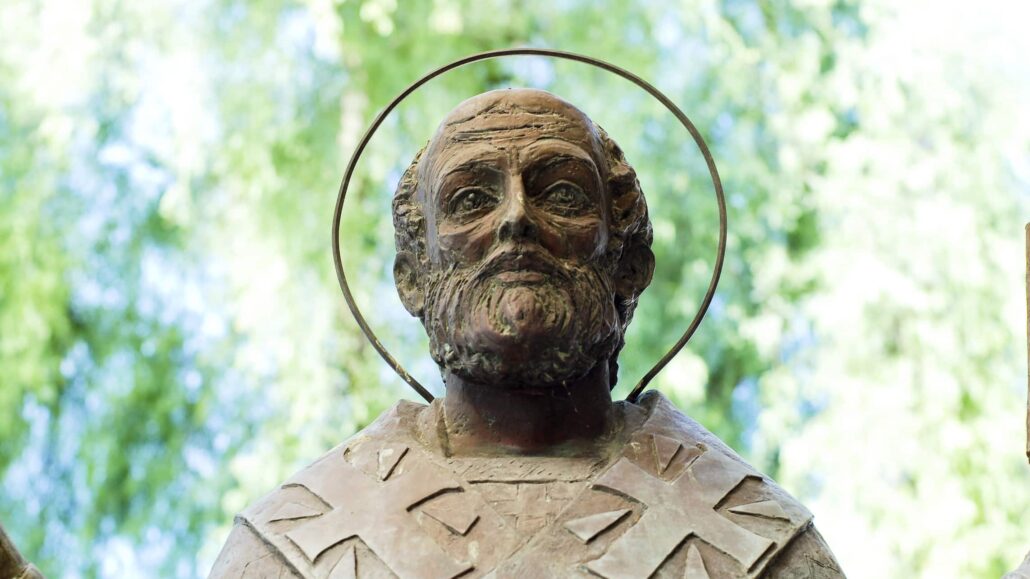To many Christians, St. Nicholas, precursor to Santa Claus, is no quaint figure from the past. Especially to Eastern Catholics and the Orthodox, he is one of the most popular saints, constantly interceding on behalf of his people, even today.
Due to his miraculous life and the testimony of miracles, St. Nicholas is the patron of children, of travelers, of those seeking husbands, and of many other causes. His feast is December 6.
To begin on solid ground, St. Anthony Messenger interviewed a saint authority, Father Nicholas Palis of Aliquippa, Pennsylvania. Father Palis, pastor of Dormition of Theotokos Greek Orthodox Parish, translates lives of the saints from Greek to English.
He is a graduate of the Hellenic College in Brookline, Massachusetts, and the University of Thessalonica in Greece.
Really a Saint
So many legends have cropped up around St. Nicholas that some commentators question whether he really existed. Father Palis graciously answers this potentially offensive question about Nicholas’s basis in real life: “You’ve got his relics that give out myrrh in Bari, Italy, and different parts of his relics in other parts of the world! How can you have the relics of the saint and then question whether or not that saint exists?”
Of the few things we can say with historical certainty about this saint of early Christianity is that he indeed lived. He was born in 280 and his see was on the Mediterranean coast, in an area where St. Paul had first brought the gospel a few hundred years earlier. The busy seaport of Myra, in the Asia Minor province of Lycea, is present-day Demre, Turkey. He was such a devoted and holy bishop that, much like Mother Teresa today, the people immediately recognized him as a saint. Thus, the Church kept careful track of his remains after he died in about 342.
A church was built to house these revered remains by Emperor Constantine, who had freed Christians, including Nicholas, from prison and torture under the Diocletian persecution. More than 500 years later, at the time when the Muslim Turks took possession of the area, his remains were removed for safekeeping across the waters to Bari, Italy, where they remain today.
In a highly symbolic ecumenical gesture just 30 years ago, the Holy See approved the return of several relics of St. Nicholas to the Greek Orthodox Church in Flushing, New York, where they are enshrined at St. Nicholas Orthodox Church. The December 1972 ceremony was led by Archbishop Iakovos, then the Greek Orthodox primate of North and South America, and the late Bishop Francis Mugavero, Roman Catholic bishop of Brooklyn, New York.
Bari, Italy, celebrates a feast May 9 of each year, as it has since 1087, celebrating the transfer of Nicholas’s remains to St. Nicholas Cathedral there. Thus, sometimes Nicholas of Myra is called Nicholas of Bari.
Nicholas’s remains, from the beginning, were observed to exude a sweet-smelling oil, or myrrh, called “St. Nicholas Manna.” Many have sought these oils over the centuries for their healing powers. “They are a sign of the purity of Nicholas’s life,” says Father Palis, that his body, even in death, is uncorrupt and sweet. Palis himself once received a vial of this myrrh, which he used for anointing the sick in his pastoral care.
Palis, from his studies, raises the question of whether or not there was actually more than one Nicholas. He refers to a manuscript of one “St. Nicholas of Zion,” a beloved and well-known abbot at Mount Zion Monastery near Myra, who lived around the time of Archbishop Nicholas. This abbot traveled to the Holy Land and returned, and is credited with miracles at sea along the way. Two Nicholases could have blended into one story over time, says Father Palis. That would explain some of the contradictions in Nicholas’s sketchy biography.
For example, some accounts have Nicholas being named a bishop while still a boy, due to a stalemate in the local community’s bishop election. Other accounts have Nicholas as an abbot of the monastery being named bishop.
All of that is really academic, says Father Palis, when we consider what St. Nicholas, the archbishop, teaches us.
Witness of Love
The very name Nicholas derives from two Greek words, Niki (“victory”) and laos (“people”), explains Father Palis. Thus, Nicholas means one who is victorious with the people. “But he’s not victorious through some polemical means, but rather victorious through his saintly life. I think St. Nicholas always moves people to imitate his virtues of charity, love and zeal.”
Most people focus on the charity of St. Nicholas, yet forget another of his key virtues, his asceticism, says Father Palis: “Most people think of him, due to the influence of Santa Claus, as a roly-poly, heavyset fellow. But the feeling I get from reading the life of the saint is that he was a man of very great prayer and fasting. He must have been a holy person indeed to work all these miracles, and to have such a godly zeal.”
Father Palis finds the story of Nicholas’s ordination especially moving. “He’s surprised by it. The bishops got together and they prayed, and it was by divine revelation that they were told, ‘The next person who runs into church, nab him and make him bishop.’ It shows that it’s not only his own will, but God is calling him to pastor his flock.”
Nicholas sets an example, says Palis, “as a godly bishop who has a strong zeal for his people.” That devotion is evident in his daring protection of those being treated unjustly (see story below) and his selfless giving to those in need. “He’s fasting and praying a lot for his people,” adds the priest.
Patron of Travelers
Greeks are especially devoted to Nicholas because he is the patron of seafarers, and Greece is a seafaring country. “Every boat in Greece has an icon of Nicholas, with a vigil lamp before it,” says Father Palis.
In fact, there are more churches named after St. Nicholas than any other saint, according to some sources, with the possible exception of the Blessed Mother.
In the weeks following September 11, 2001, the Greek Orthodox congregation of historic, tiny St. Nicholas Church in Manhattan, destroyed in the collapse of the World Trade Center towers, took a full-page ad in The New York Times to announce their intention to rebuild. In the ad they invoked Nicholas as the patron of all travelers, including airline passengers.

Defender of the Faith
A final aspect of Saint Nicholas is not to be forgotten, says Father Palis. He suffered for his faith. Nicholas lived in the awful time of Christian persecution at the hands of Roman emperors. He survived torture in prison to live through the incredibly challenging years of the newly freed Church defining its doctrines.
When Emperor Constantine brought Christianity out of hiding and prison in the fourth century, the Church faced an empire-wide debate between the Egyptian theologians Arius and Athanasius over the divinity of Jesus. Followers of these two literally rioted in the streets against each other. The issue, brewing for some time, was supposedly settled in 325 at the Council of Nicea, source of the Nicene Creed prayed at Mass today. But the struggle over this doctrine of Jesus’ divinity continued for decades.
There is an apocryphal story that Archbishop Nicholas, at the Nicene Council, was so infuriated at the Arian bishops who denied Jesus’ full divinity that he slapped one in the face! He was censured, the story goes, until the same bishops had a dream in which God told them to reinstate Nicholas. They reinstated him. This story, true or not, put Nicholas squarely on the side of those who proclaimed Jesus as “one in being with the Father” in the struggle to capture the minds and hearts of Christians of the day.
We can thank Saint Nicholas, and others like him, that the acceptance of Jesus’ full divinity carried the day as the Church grew.
Nicholas and Jesus
In these days before Christmas, we can celebrate the feast of Nicholas as a time to refocus on Jesus. Saint Nicholas showed us how to find Jesus in the poor, the oppressed and abused. He was devoted to charity, but charity always linked to justice.
Nicholas teaches us that faithful followers of Jesus defend those who are wrongly accused. Today we can see the face of Jesus not only in political prisoners around the world, but also in anyone who suffers from false accusation. After all, wasn’t Jesus himself executed on false charges?
Finally, Saint Nicholas shows us how to find Jesus through prayer and religious zeal.
Let’s relish the spirit of joy and charity embodied in Santa’s gift-giving, but let’s not forget the real Saint Nicholas, who, like all the saints, points to Jesus. That’s the truest Christmas spirit.
Patron of Sailors
There are countless stories of Saint Nicholas intervening to help sailors in times of distress. The most famous is told of a time when Nicholas went across the sea on pilgrimage to the Holy Land. A frightful storm came up, and the sailors feared they all were about to die. They came to the holy bishop and pleaded for his help. Nicholas prayed fervently, and the seas became miraculously calm. The sailors were amazed and gave praise to God.
It is said that on the return voyage a sailor fell to his death from a high mast. Nicholas prayed over the man and he came back to life. Nicholas never took credit for any of his deeds. He always instructed the people to turn their hearts to God and repent from sin.
Nicholas and the Falsely Accused
The emperor sent three princes to Lycea to stop a rebellion nearby. Their names were Nepotian, Ursyna and Apollyn. Stormy weather at sea forced them into the port of Myra, where Nicholas was bishop. Nicholas invited them to dine with him and other dignitaries of the town. While at dinner, though, the consul, a corrupt man, ordered that the three innocent princes be beheaded. Whether the consul sought to aid the rebellion or steal the princes’ money is not clear.
Saint Nicholas was horrified at this mistreatment. Even as the executioner had his sword raised over the princes’ heads, Nicholas stormed into the room and blocked the executioner! He had the men unbound and led them to safety. Then he confronted the corrupt consul, who repented. Nicholas blessed the princes and sent them on their way.
After making peace with the rebellion leaders, they sailed to Constantinople, where the emperor awaited their report of success. As it turned out, there was further plotting against them and they wound up in prison again, sentenced to be executed. One of them persuaded the others to pray to Nicholas.
That night, Nicholas appeared in a dream to Emperor Constantine and commanded him to free the innocent men, which he did. When they heard the news, they fell to their knees and praised God! Finally, they were allowed to return to their homes.
Over the years, Saint Nicholas interceded in the courts for many others who were falsely accused.
Nicholas and the Three Maidens
Nicholas was the son of wealthy parents who died while he was a child. Despite the insecurity of being an orphan, he selflessly wanted to share this wealth with those in need. In those times, like today, wealth and poverty lived side by side.
Nicholas was aware of a man who had three teenage daughters. The family was so poor they could not fill their bellies. And, without money for a dowry, there was no way the girls would ever find a husband. Faced with starvation, their only option would be prostitution.
Nicholas, wishing to remain anonymous, one night tossed a bag of gold through the window of their house. When the man awoke the next morning, there it was! He thanked God for his good fortune. Thus, the oldest daughter was able to marry. A little while later, Holy Nicholas repeated the act for the second daughter.
By now the father wanted to know who was behind this magnificent act. The night he heard the third bag of gold hit the floor beneath his window, he rushed out and caught up with the fleeing Nicholas. The saint swore him to secrecy, but eventually the story got out.








